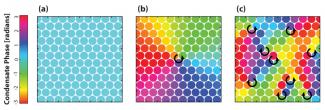In the quantum world inside Fellow Eric Cornell’s lab, communication occurs across a two-dimensional lattice array of Bose-Einstein condensates (BECs) when atoms tunnel out of superatoms (made from about 7000 garden-variety rubidium (Rb) atoms) into neighboring BECs. This communication keeps the array coherent, i.e., the phases of all condensates remain locked to each other. But something interesting happens when the tiny superatoms stop communicating among themselves. Vortices form. And how many appear depends on temperature.
In a recent experiment, Graduate Students Volker Schweikhard and Shihkuang Tung showed for the first time exactly how the process works. First, they learned how to precisely control the level of communication among the BECs in their lattice array by controlling the intensity of the light field that defines the array. Then as this field grew stronger, they found that it got harder for atoms to emerge from a condensate and tunnel across to nearby superatoms. Eventually, tunneling became so weak that communication essentially stopped. Once communication failed, they discovered that another process begins to dominate: thermal agitation. At warmer temperatures, agitation caused vortices to form randomly in the condensate array.
Warmer temperatures can destroy system-wide coherence in a condensate array that isn’t communicating. This happens because warmer temperatures cause more uncondensed Rb atoms around the condensates to move around faster, making it more likely that one of them will crash into one of the superatoms. These collisions can change the phase of a BEC. However, if there is good communication happening, the array of condensates corrects itself back into a coherent state. In contrast, the failure to communicate prevents energetic self correction, and the developing phase changes will lead to the formation of vortices. The number that form depends on temperature and on the level of communication between the condensates. In fact, the researchers found that vortex formation is controlled exclusively by the ratio of thermal agitation to coherence-restoring communication.
The challenge now is for theorists to explain why all this happens the way it does. So far, there are no theories that describe atom-condensate collisions in this kind of array, much less predict the maximum number of vortices that will form under specific conditions. Volker and his colleagues are looking forward to having a theorist fill in this piece of the puzzle. One reason the theoretical issue is particularly intriguing is the difficulty of including temperature effects in the description of quantum mechanical systems at the fundamental level. The question arises whether the observed temperature dependence of vortex formation takes place in the nebulous transition between the tiny world where the laws of quantum mechanics predominate and the larger world explained by classical physics. - Julie Phillips



 The Physics Frontiers Centers (PFC) program supports university-based centers and institutes where the collective efforts of a larger group of individuals can enable transformational advances in the most promising research areas. The program is designed to foster major breakthroughs at the intellectual frontiers of physics by providing needed resources such as combinations of talents, skills, disciplines, and/or specialized infrastructure, not usually available to individual investigators or small groups, in an environment in which the collective efforts of the larger group can be shown to be seminal to promoting significant progress in the science and the education of students. PFCs also include creative, substantive activities aimed at enhancing education, broadening participation of traditionally underrepresented groups, and outreach to the scientific community and general public.
The Physics Frontiers Centers (PFC) program supports university-based centers and institutes where the collective efforts of a larger group of individuals can enable transformational advances in the most promising research areas. The program is designed to foster major breakthroughs at the intellectual frontiers of physics by providing needed resources such as combinations of talents, skills, disciplines, and/or specialized infrastructure, not usually available to individual investigators or small groups, in an environment in which the collective efforts of the larger group can be shown to be seminal to promoting significant progress in the science and the education of students. PFCs also include creative, substantive activities aimed at enhancing education, broadening participation of traditionally underrepresented groups, and outreach to the scientific community and general public.